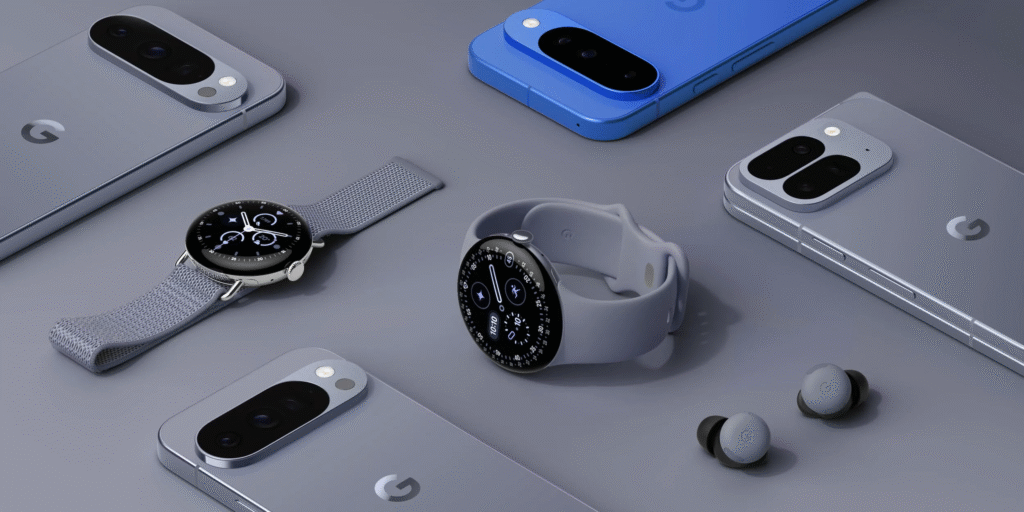
- The Curtain Rises on Confusion
- Format Innovation or Strategic Misstep?
- The Technology Behind the Theatre: Evolution, Not Revolution
- Google's Strategic Insecurity Problem
- Market Reality Check: The Numbers Don't Lie
- Competitive Landscape: Matching, Not Leading
- The Indian Market: A Microcosm of Global Dynamics
- Impact on Smartphone Evolution
- Lessons for Digital Marketing Professionals
- The Attention Economy's Diminishing Returns
- Strategic Implications: Beyond the Spectacle
- The Morning After: Lessons in Digital Loyalty
- Conclusions: When Spectacle Obscures Substance
The Curtain Rises on Confusion
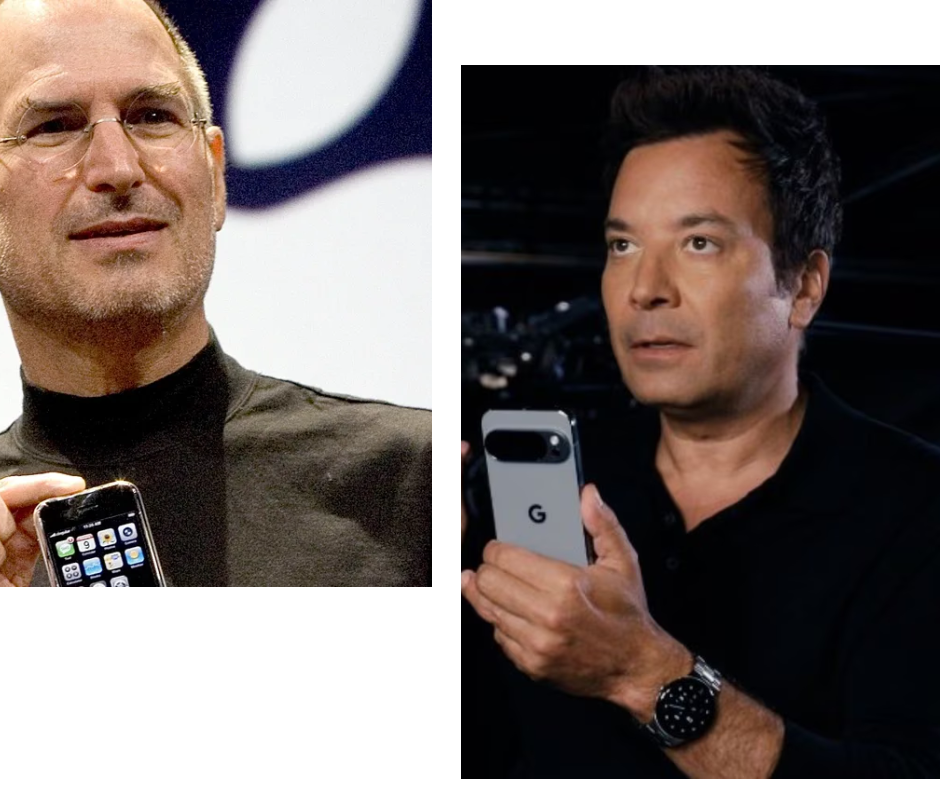
Hours after Google’s Brooklyn extravaganza concluded, the most damning review came not from tech journalists but from YouTube’s comment section: “I still don’t know why I’d buy this over an iPhone.” For a company that reportedly spent millions on celebrity cameos, that single sentence encapsulates the evening’s fundamental failure.
As explored in The Pixel Paradox, Google’s relationship with digital natives has always been complex—we use their search whilst preferring their competitors’ hardware, champion their AI whilst questioning their execution. The Made by Google 2025 event, broadcast on 20 August, crystallised these contradictions into spectacular form.
Google’s event represented a significant departure from conventional technology presentations—though not necessarily for the better. Hosted by Jimmy Fallon and featuring a cavalcade of celebrities including Stephen Curry, the Jonas Brothers, and Alex Cooper, the event attempted to democratise tech announcements through entertainment value. Instead, it produced what many critics described as a “cringefest” that undermined what should have been a straightforward presentation of iterative improvements.techcrunch+1
“Google substituted technical insight for zingers, swapped ensemble chemistry for celebrity drop-ins, and staged a set where every product reveal begged the question: am I watching a keynote or a parody?”
The irony wasn’t lost on industry observers: here was Google, a company built on algorithmic precision, betting its premium hardware future on the ancient art of celebrity endorsement. It was rather like watching a chess grandmaster who had all of a sudden decided to play poker—technically possible, but raising questions about whether they understood the game they were actually playing.
Format Innovation or Strategic Misstep?
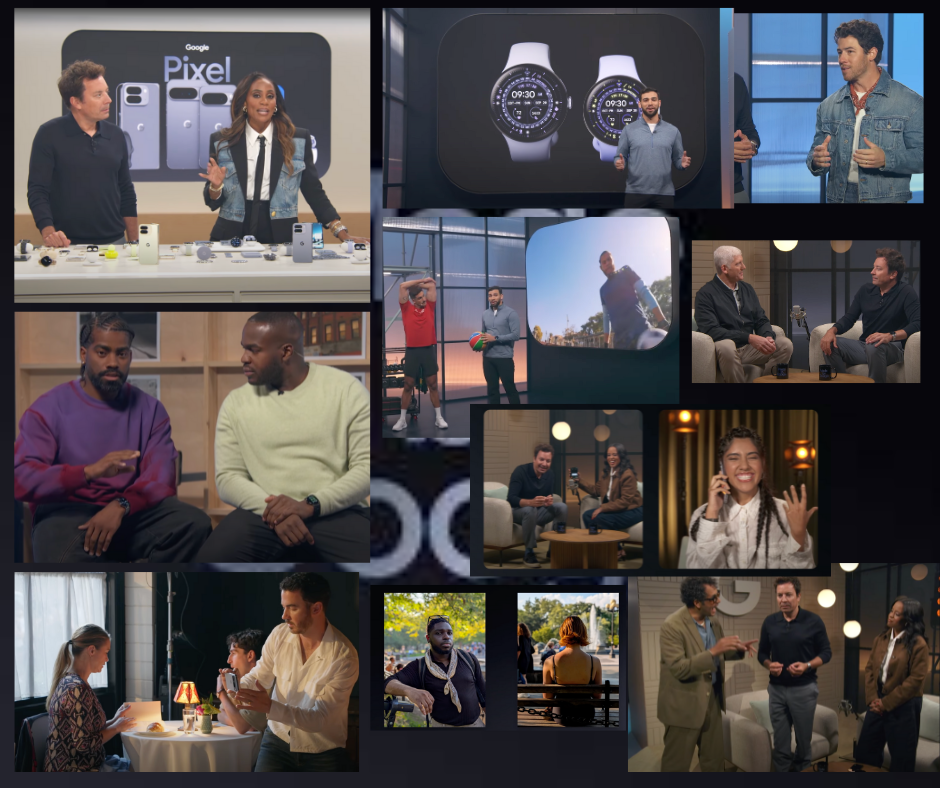
As previously analysed, Google’s strategic insecurity stems from playing Apple’s game whilst Apple never reciprocates. This dynamic became painfully evident in Brooklyn, where Google’s decision to transform its hardware presentation into what resembled a late-night talk show was driven by a clear strategic imperative: reaching beyond the tech-savvy bubble to capture mainstream consumer attention. suchetanabauri+1
The company assembled an impressive roster of talent, but the execution felt painfully contrived. Fallon’s performance was particularly problematic, marked by what observers called “forced enthusiasm” and a visible discomfort with the technology that he was supposed to champion. His repeated shouting of “I P 6 8! I P 6 8!” to generate excitement about water resistance—a feature that has existed in Pixel phones since 2018—epitomised the disconnect between showmanship and substance. news.ssbcrack
“Jimmy Fallon, a man constitutionally incapable of sincerity for more than six seconds at a time, works best when chaos is the point. Here, as ‘host of Google’s AI future,’ he bumbled through tepid one-liners and contrived enthusiasm for water-resistance ratings.”
The most damning aspect of the presentation was its condescending tone—exactly the kind of approach that alienates the digitally sophisticated consumers Google claims to understand. As established in The Pixel Paradox, we digital natives practice “pragmatic polygamy” with our technology choices. We don’t need celebrities to explain why features matter; we need honest assessments of how they work.
The Technology Behind the Theatre: Evolution, Not Revolution
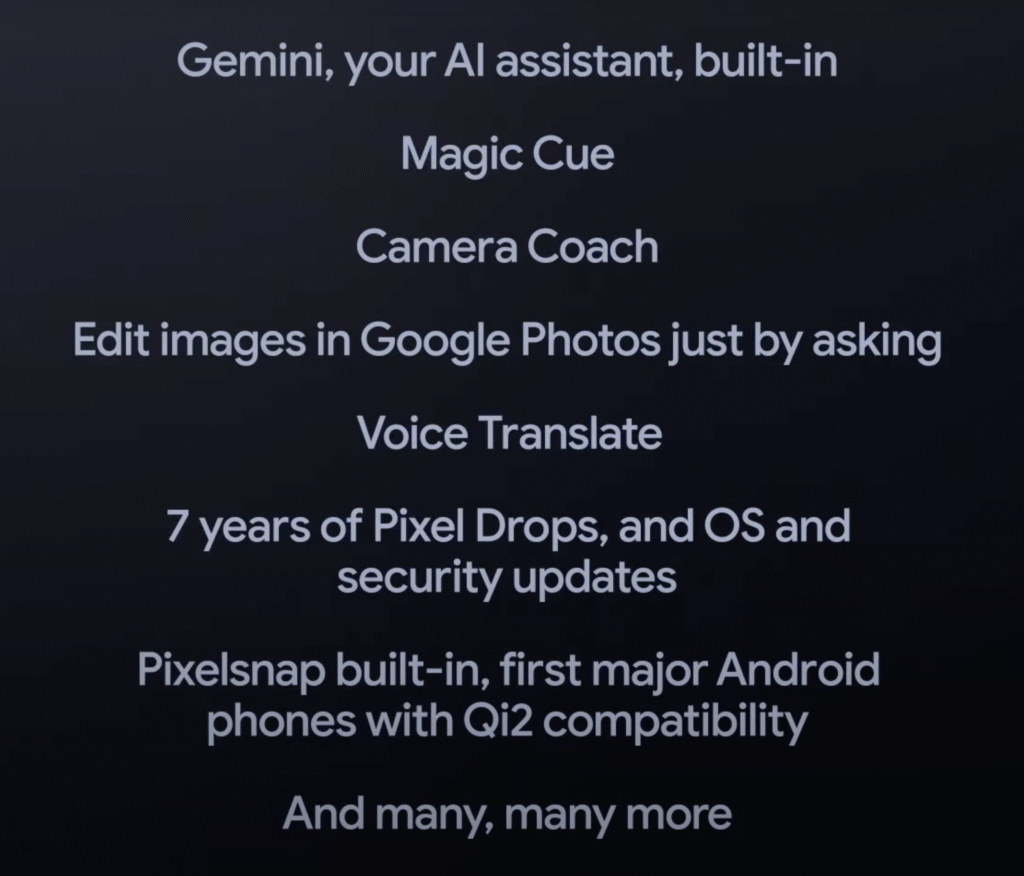
Beneath the theatrical veneer lay technological advances that, whilst competent in isolation, can be hardly be called revolutionary breakthroughs as Google’s spectacle suggested. Strip away the celebrity endorsements and marketing hyperbole, and what emerges is a familiar pattern: incremental improvements to existing smartphone capabilities, rebranded as paradigm shifts.
The Tensor G5 chip, Google’s “most significant silicon upgrade,” represents a competent but unremarkable progression. Manufactured on TSMC’s 3nm process—the same node used by Apple’s A18 Pro—it delivers the expected generational improvements: 34% faster CPU performance, 60% more powerful TPU. These are the kinds of year-on-year gains the industry has delivered for decades, hardly the stuff of revolutionary change.nanoreview
“Strip away the celebrity endorsements and marketing hyperbole, and what emerges is a familiar pattern: incremental improvements to existing smartphone capabilities, rebranded as paradigm shifts.”
Magic Cue’s Contextual Déjà Vu
Magic Cue, Google’s supposed “software innovation,” offers contextual AI assistance that surfaces relevant information based on user behaviour. Yet Samsung’s Galaxy S25 series already provides similar functionality through its Cross App Actions, allowing users to execute complex tasks across multiple applications with single voice commands. Apple’s Siri has offered contextual suggestions based on usage patterns for years, whilst Microsoft’s Cortana pioneered proactive assistance nearly a decade ago.google+2
The promise—automatically presenting flight details when ringing airlines, suggesting photos during conversations—sounds impressive until one realises these are precisely the features that digital assistants have attempted (and often failed) to deliver reliably since their inception.corp.yonyx
Camera AI: The Zoom Arms Race Continues
Google’s camera enhancements follow well-worn industry paths. Camera Coach for real-time composition suggestions? Apple’s iPhone 16 Pro offers similar guidance through its Camera Control system. Pro Res Zoom’s 100x magnification through generative AI? Samsung achieved 100x zoom on the Galaxy S20 Ultra in 2020, and has refined the feature through successive generations.apple+2youtube
The real-time voice translation that “preserves speaker characteristics” sounds impressive until you realise Samsung’s Galaxy S24 series already offers live call translation across 20 languages, whilst dedicated translation apps like AI Phone provide similar functionality across 150+ languages. What Google presents as innovation is essentially feature parity wrapped in marketing speak.aiphone
“The uncomfortable truth is that virtually every ‘breakthrough’ feature exists in comparable form across the smartphone ecosystem—contextual AI, advanced zoom, on-device processing are industry standards, not Google innovations.”
The AI Processing Reality Check
On-device AI processing, Google’s supposed privacy breakthrough, has become table stakes in premium smartphones. Apple’s Neural Engine has enabled on-device AI since 2017’s iPhone X. Samsung’s Galaxy S25 series processes AI requests locally through its Snapdragon 8 Elite chipset. Even Chinese manufacturers like Xiaomi and Honor offer comparable on-device AI capabilities.samsungmobilepress+1
Google’s Gemini Nano integration, whilst technically competent, faces the same reliability issues that plague the company’s broader AI offerings. Users consistently report that Gemini provides lower-quality responses than competitors, with the system “ignoring constraints and delivering substantially less comprehensive analysis”.engadget
Innovation or Iteration?
The uncomfortable truth about Google’s Brooklyn showcase is that virtually every “breakthrough” feature exists in comparable form across the smartphone ecosystem. Contextual AI assistance? Samsung’s Cross App Actions. Advanced zoom capabilities? Samsung and Apple have been competing in this arena for years. On-device AI processing? Industry standard since at least 2017.
What Google presented as revolutionary represents, at best, competent execution of established smartphone capabilities. The company’s genuine computational photography leadership—Night Sight, HDR+ processing—remains impressive, but these advantages have narrowed considerably as competitors have caught up.
“What Google presents as innovation is essentially feature parity wrapped in marketing speak.”
The broader question raised by Google’s theatrical presentation isn’t whether these features work (they largely do), but whether they justify the company’s positioning as an AI smartphone leader when competitors offer similar capabilities with less fanfare and, often, better execution. Sometimes the most impressive innovation is admitting when you’re playing catch-up rather than leading the charge.
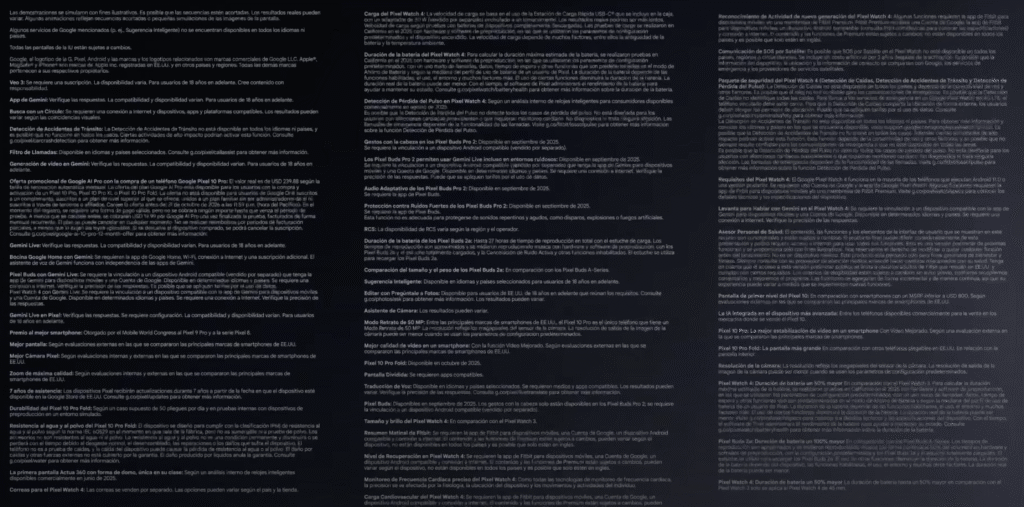
Google’s Strategic Insecurity Problem
The event highlighted a fundamental tension explored in The Pixel Paradox: Google’s positioning as the AI smartphone leader rings hollow when the company’s own AI tools prove frustratingly inconsistent in real-world use. As a digital marketing professional who regularly switches between AI tools depending on task requirements, this inconsistency is professionally problematic.
Google’s AI search provides incorrect answers over 60% of the time when citing news articles, with systems showing “alarming confidence” despite frequent inaccuracies. Users consistently report that Gemini’s responses are lower quality than competitors, with the system ignoring constraints and delivering “substantially less comprehensive analysis” than alternatives like Claude or ChatGPT.engadget
“Google’s AI often sounds authoritative whilst being demonstrably wrong—a combination that proves more dangerous than obvious uncertainty.”
This creates a peculiar contradiction: Google champions AI capabilities whilst delivering demonstrably flawed AI experiences. The company’s aggressive AI integration serves a clear strategic purpose—establishing technological superiority whilst Apple struggles with delayed AI rollouts—yet this positioning reveals Google’s fundamental challenge. Each mockery of Apple’s “coming soon” features becomes a confession that Apple sets the rules for premium smartphone competition.
As previously noted, “Google is insecure because it’s playing Apple’s game (premium hardware + ecosystem) whilst Apple never plays Google’s (ad revenue + open platform)”. The Brooklyn spectacle was merely the latest manifestation of this strategic disadvantage.suchetanabauri
Market Reality Check: The Numbers Don’t Lie
The uncomfortable mathematics of aspiration, as detailed in The Pixel Paradox, remained unchanged by Brooklyn’s theatrics. In Q2 2025, Google shipped 800,000 Pixel devices in the United States—capturing merely 3% of American market share. Samsung, by contrast, shipped 58 million smartphones globally, whilst moving approximately 8.3 million units in the US alone—outselling Pixel by 10 to 1 even in Google’s strongest market.timesofindia.indiatimes
The global picture proves even more sobering. Samsung outsells Google Pixel by 72.5x globally, yet Google’s marketing spend positions them as equals in the AI smartphone revolution. In Europe, Pixel manages roughly 400,000 quarterly units across EU5 markets—hovering below 2% market share. In India, despite significant investment, Google holds under 4% of the premium segment.
“Samsung outsells Google Pixel by 72.5x globally, yet Google’s marketing spend positions them as equals in the AI smartphone revolution.”
This disconnect between marketing ambition and market reality explains the theatrical desperation of the Brooklyn event. When you’re fighting for relevance rather than dominance, spectacle becomes a substitute for substance—a dangerous gambit that can alienate the very audience you’re trying to court.
The evening celebrated ten generations of Google’s Pixel line, rendered in sparkly teasers threaded with Dr. Dre’s “The Next Episode”—a sonic signature that simultaneously suggests progression and delivers a coded critique of Apple’s approach to innovation. Yet numbers tell a different story than the spectacle suggests.
Competitive Landscape: Matching, Not Leading
Google’s AI features largely match what competitors already offer, rather than providing the revolutionary advantage the Brooklyn spectacle suggested. Features like Magic Cue, real-time translation, and advanced camera coaching exist in comparable forms across the premium smartphone ecosystem, representing competitive parity rather than the breakthrough leadership Google’s presentation implied.
However, as established in The Pixel Paradox, digital professionals practice platform agnosticism born of functional necessity rather than brand loyalty. I use an iPhone because Apple’s ecosystem integration remains unmatched for daily productivity, yet I search with Google because their algorithms understand context and intent in ways alternatives haven’t matched.
Apple’s approach to technology communication provides an instructive contrast. When Apple announces features, they focus on practical benefits rather than technical specifications. Their presentations feel earnest rather than entertaining, educational rather than theatrical. Most importantly, they respect their audience’s intelligence whilst remaining accessible to newcomers.
“Apple defines the battlefield, and Google reacts. The parallel with Pixar proves particularly intriguing—Google’s attempt to challenge Apple’s premium dominance uses branding that echoes the very innovator who defined premium technology marketing.”
Samsung, meanwhile, continues to dominate through practical innovation and global reach. Their Galaxy S25 series, launched just months before Google’s event, demonstrated mature AI features without theatrical fanfare. Samsung’s approach—steady innovation, reliable hardware, global availability—proves that market leadership requires consistency rather than spectacle.
The Indian Market: A Microcosm of Global Dynamics
From India’s rapidly evolving smartphone market perspective, Google’s Brooklyn spectacle takes on additional complexity. As explored in The Pixel Paradox, the challenge for any global brand in India is crafting campaigns that say “for you” as convincingly as they say “from here.”
India’s smartphone market reached a record average selling price of $275 in Q2 2025, with the premium segment projected to exceed 20% market share. This premiumisation creates opportunities for Google, yet the company remains marginalised. Samsung recently overtook Apple in India’s super-premium segment (49% vs 48%), whilst Google Pixel doesn’t register meaningfully in most analyses.financialexpress
Indian consumers, particularly in the premium segment, have grown sophisticated about celebrity endorsements. Research shows increasing scepticism towards endorsements that feel inauthentic, with 500% increases in sponsored content disclosure requirements reflecting growing transparency demands.
“The market is premiumising, yes, but Indians are swiftly outgrowing their appetite for inauthentic celebrity influence. Pixel’s photographic verve is undeniable; its actual uptake, less so.”
Google’s celebrity-heavy presentation approach seems particularly tone-deaf in this context—exactly the kind of manufactured authenticity that sophisticated consumers have learned to reject. The Brooklyn spectacle represented everything Indian consumers have grown wary of: transactional celebrity partnerships, oversimplified explanations, and spectacle over substance.
Impact on Smartphone Evolution
Despite presentation shortcomings, Google’s incremental improvements suggest modest evolution rather than revolutionary change in smartphone capability. On-device AI processing, whilst presented as breakthrough innovation, represents the continuation of established industry trends rather than paradigm-shifting advancement.
The camera’s AI coaching capabilities suggest smartphones continuing their gradual transition from simple capture devices to more sophisticated creative tools. However, these features largely parallel developments across the industry, with Apple, Samsung, and Chinese manufacturers all pursuing similar computational photography advances.
Magic Cue’s contextual intelligence represents incremental progress in smartphone proactivity, yet similar capabilities exist across competing platforms. The challenge, as outlined in The Pixel Paradox, is that we don’t choose single brands anymore; we curate ecosystems based on specific strengths.
“Google’s innovations will likely be adopted by competitors within months, leaving Google with the challenge of converting technical parity into market dominance.”
Google’s contributions will influence industry standards—computational photography and voice translation refinements will propagate across brands. Yet these represent evolutionary improvements rather than revolutionary breakthroughs, raising questions about whether Google’s theatrical presentation matched the significance of the underlying technology.
Lessons for Digital Marketing Professionals
Google’s Brooklyn experiment offers several critical insights for marketing professionals navigating the attention economy, building on themes established in The Pixel Paradox:
Authenticity Trumps Celebrity Wattage
Particularly in sophisticated markets like India, consumers distinguish between star power and product substance. Celebrity partnerships require genuine product-celebrity alignment rather than transactional arrangements. The most effective endorsements feel organic rather than orchestrated—exactly what Google failed to achieve.
Respect Your Audience’s Intelligence
The most damaging aspect of Google’s presentation was its condescending tone. As established previously, digital natives have grown sophisticated about detecting inauthentic marketing. Modern consumers, especially in technology markets, possess sophisticated bullshit detection systems. Oversimplification alienates rather than attracts, particularly when dealing with complex innovations.
“As every marketer worth their ‘Chief Questions Officer’ lapel pin knows, today’s consumer is less tolerant of hyperbole, more attuned to substance, and increasingly suspicious of celebrities reading copy off Teleprompters.”
Substance Over Spectacle in B2B-Adjacent Markets
Technology purchases, even consumer ones, often involve research and consideration. Spectacular presentations may generate initial attention, but purchase decisions depend on practical benefits and reliable performance. The gap between marketing promises and product reality becomes particularly costly in trust-dependent categories.
Ecosystem Integration Matters More Than Individual Excellence
As explored in The Pixel Paradox, Apple’s success stems not from making the best individual products but from creating seamless experiences across devices and services. Google’s fragmented approach—excellent search, inconsistent AI, capable hardware with limited market presence—reflects a company that excels at components but struggles with systems.
AI Marketing Requires Practical Positioning
Rather than leading with technical capabilities, successful AI marketing focuses on practical benefits and simplified use cases. Consumer scepticism towards AI features suggests careful positioning around genuine utility rather than impressive-sounding specifications. Google’s Brooklyn presentation violated this principle spectacularly.
Feature Parity Requires Honest Messaging
When your innovations represent competitive catch-up rather than breakthrough leadership, honesty serves better than hyperbole. Google’s presentation suffered from positioning iterative improvements as revolutionary advances, creating expectations the product couldn’t fulfil whilst alienating audiences seeking authentic communication.
The Attention Economy’s Diminishing Returns

Google’s event represents a broader trend explored in The Pixel Paradox: the entertainmentification of serious discourse. Just as politics increasingly resembles reality television, technology announcements now resemble variety shows. This approach may capture attention but risks trivialising genuinely significant innovations.
The format felt oddly familiar to anyone who recalls the late-night television landscape of the 1980s and 1990s—those interminable infomercials featuring “apparently funny men” hawking kitchen gadgets and cleaning products. Ron Popeil’s “Set it and forget it!” enthusiasm, Billy Mays’ booming OxiClean declarations, and Vince Offer’s ShamWow theatrics all shared common DNA with Google’s Brooklyn production.infomercial+2
“The first television infomercial was for the Ronco Chop-o-Matic. It quickly spread nationally and made millions, turning Popeil into a household name—the very template Google tried to recreate in Brooklyn.”ronpopeil
What’s particularly astute about this parallel is how Google’s celebrity-studded affair mirrors the infomercial format almost exactly: the manufactured enthusiasm, the forced demonstrations, the “but wait, there’s more!” energy—except instead of Mighty Putty or the Swivel Sweeper, it was IP68 water resistance and Magic Cue. Fallon’s role was essentially that of a modern Billy Mays, minus the authentic product knowledge and genuine enthusiasm that made the originals work.
The crucial difference? Those infomercial pitchmen succeeded because they genuinely believed in their products and understood their audience’s needs. Mays famously used every product he endorsed. Google’s Brooklyn production felt more like parody than genuine advocacy—all the theatrics of an infomercial, but none of the authenticity that made viewers reach for their wallets at 2 AM.wikipedia
It’s rather telling that Google, in trying to democratise tech announcements, ended up recreating the most maligned form of television advertising—complete with the same condescending assumption that audiences need entertainment to digest simple product information.
The decision to prioritise celebrity appearances over technical depth reveals an assumption that modern audiences cannot engage with complexity—a premise that both underestimates consumers and degrades public discourse around technology. In an era of manufactured content and algorithmic curation, authenticity commands premium value.
“In an attention economy that increasingly demands spectacle, the path to genuine engagement may paradoxically lie in authentic simplicity rather than manufactured excitement.”
The few genuine moments in Google’s presentation—the photographer discussing his craft, natural engagement with actual product benefits—stood out precisely because they felt real. This suggests that abandoning theatrical presentation for honest technical communication might actually prove more effective.
As noted in The Pixel Paradox, “spectacle opens doors, but routine reliability determines which ones people walk through.” Google’s Brooklyn show succeeded in opening doors—generating conversation, trending hashtags, creating cultural moments. But converting cultural relevance into sustainable competitive advantage requires closing the gap between marketing ambition and daily utility.
Strategic Implications: Beyond the Spectacle
The event’s reception suggests deeper strategic challenges for Google beyond presentation failures. As explored in The Pixel Paradox, the company possesses competent technology but struggles to communicate its value proposition without either overwhelming consumers with complexity or insulting their intelligence with oversimplification.
Google’s hardware strategy demonstrates coherent long-term thinking despite presentation shortcomings. The integration of Tensor chips, on-device AI processing, and ecosystem accessories creates a competent alternative to Apple’s walled garden, though one that largely matches rather than exceeds competitor capabilities. The company’s commitment to seven years of software updates further reinforces premium positioning.google
However, Google faces fundamental competitive disadvantages that spectacle cannot address. Apple’s ecosystem integration remains unmatched for daily productivity, whilst Samsung’s global manufacturing and distribution capabilities dwarf Google’s hardware ambitions. Most critically, Google’s business model—built on advertising rather than hardware sales—creates inherent conflicts between user privacy and revenue generation.
“Google has shown that it is possible to maroon competent technology amid its own spectacle, that a cavalcade of celebrities cannot disguise fundamental questions of use and value.”
The parallel with Steve Jobs’ Pixar becomes particularly intriguing here. Whether intentional or not, Google’s choice of “Pixel” carries similar connotations to what Jobs achieved with Pixar: premium quality over mass market appeal, technological innovation as differentiator, end-to-end experience control. The naming choice becomes symbolically perfect—Google’s attempt to challenge Apple’s premium dominance uses branding that echoes the very innovator who defined premium technology marketing.
Yet where Pixar achieved genuine creative breakthrough, Google’s Pixel represents competent execution of established smartphone capabilities. The theatrical presentation couldn’t disguise this fundamental difference between revolutionary innovation and evolutionary improvement.
The Morning After: Lessons in Digital Loyalty
In the cold light of analysis, digital loyalty continues to be measured not in hashtags or star power, but in the quiet efficiency of daily use. As established in The Pixel Paradox, those of us who write on MacBooks but troubleshoot Android issues, who search with Google but analyse with Claude, know this: the digital native’s life is one of pragmatic promiscuity—a constant negotiation between aspiration and reality.
This technological polygamy reflects broader consumer behaviour that Google’s Brooklyn spectacle seemed to misunderstand. We don’t choose single brands anymore; we curate ecosystems based on specific strengths. Google’s incremental improvements will be evaluated not against marketing promises, but against daily utility and competitive alternatives.
“We don’t choose single brands anymore; we curate ecosystems based on specific strengths—a reality that Google’s Brooklyn spectacle seemed to fundamentally misunderstand.”
Google’s competent engineering deserved better advocacy than Jimmy Fallon’s forced enthusiasm and simplified explanations. Sometimes the most effective communication strategy is simply letting good technology speak for itself. The broader lesson extends beyond Google: in an attention economy that increasingly demands spectacle, the path to genuine engagement may paradoxically lie in authentic simplicity rather than manufactured excitement.
For professionals navigating multiple technology ecosystems daily, substance matters more than spectacle. Consumer research consistently shows that less than half of “AI-aware” groups regularly use AI features, with significant pluralities preferring their absence entirely. Marketing ambition must finally align with market reality—or risk becoming just another act in the infinite scroll.
The challenge for Google, as with any technology company operating in mature markets, is acknowledging when innovation represents evolution rather than revolution. The Brooklyn spectacle’s failure lay not in the technology it showcased—which was competent, if incremental—but in its inability to honestly position these improvements within the broader competitive landscape.
Conclusions: When Spectacle Obscures Substance
Google’s Made by Google 2025 event will be remembered not for its technological achievements but for its strategic miscalculation. The company transformed what should have been a celebration of competent engineering progress into a variety show that satisfied no one—neither the tech enthusiasts seeking substance nor the mainstream audiences supposedly craving entertainment.
As explored throughout The Pixel Paradox, Google’s relationship with digital natives is built on contradictions we’ve learned to navigate. We appreciate their search algorithms whilst questioning their AI accuracy, admire their computational photography whilst choosing competitors’ hardware for daily use.
The Pixel 10 lineup offers competent hardware at competitive prices, with AI capabilities that largely match industry standards rather than exceeding them. Magic Cue represents practical AI application that could prove useful, whilst camera improvements and ecosystem integration strengthen Google’s value proposition. These achievements deserved honest presentation rather than Brooklyn’s manufactured spectacle.
“Sometimes the most effective communication strategy is simply letting good technology speak for itself—qualities notably absent from Google’s theatrical experiment that mistook applause for adoption, spectacle for substance.”
The event’s failure offers hope alongside its cautionary tale. It suggests that consumers, far from craving constant entertainment, actually respect honest communication about complex technology. The path forward for technology marketing lies not in theatrical escalation but in authentic engagement with both innovation and audience intelligence.
For Google, the challenge remains transforming competent technology into market success through communication that respects rather than patronises its audience. The Brooklyn spectacle demonstrated what doesn’t work; the question now is whether Google will learn from its own expensive lesson in the limits of manufactured excitement.
Until then, digital natives will continue making pragmatic choices: writing on MacBooks, searching with Google, analysing with Claude, and occasionally testing Pixel phones—not out of indecision, but out of recognition that in the attention economy, the most revolutionary act might be choosing tools based on what they actually do rather than what they promise to become.
The broader lesson transcends Google’s misstep: in markets where genuine breakthrough innovation is increasingly rare, honesty about incremental progress serves brands better than theatrical overstatement. Sometimes the most impressive communication strategy is admitting when you’re playing catch-up rather than leading the charge—a lesson Google’s Brooklyn spectacle failed to learn, to its considerable detriment.
Sources:
- https://techcrunch.com/2025/08/20/google-sorry-but-that-pixel-event-was-a-cringefest/
- https://news.ssbcrack.com/googles-pixel-10-launch-event-draws-criticism-for-overhyped-celebrity-format-and-lackluster-tech-focus/
- https://suchetanabauri.com/pixel-paradox-google-marketing-reality-digital-native/
- https://9to5google.com/2025/08/19/pixel-10-event-host/
- https://nanoreview.net/en/soc/google-tensor-g5
- https://store.google.com/intl/en/ideas/categories/ai/
- https://www.tomsguide.com/ai/samsung-galaxy-s25-ai-features-heres-everything-thats-new
- https://www.samsungmobilepress.com/press-releases/samsung-galaxy-s25-series-sets-the-standard-of-ai-phone-as-a-true-ai-companion
- https://corp.yonyx.com/knowledgebase/what-is-contextual-ai-and-how-does-it-work/
- https://www.apple.com/in/iphone-16-pro/
- https://www.youtube.com/watch?v=Yxyyi5vfvlY
- https://www.croma.com/unboxed/samsung-galaxy-s25-ultra-vs-iphone-16-pro-max-camera-zoom-test
- https://www.digitec.ch/en/page/the-ultimate-zoom-comparison-is-the-samsung-s24-ultra-better-than-the-s23-ultra-31469
- https://www.aiphone.ai/blog/top-phone-call-translators/
- https://vertu.com/lifestyle/top-10-phone-technology-ai-smartphones-2025-tech-enthusiasts/
- https://www.engadget.com/ai/all-the-new-ai-features-coming-to-the-pixel-10-phones-160017270.html
- https://timesofindia.indiatimes.com/technology/tech-news/everything-google-announced-at-made-by-google-event-four-new-pixel-phones-a-new-affordable-pixel-buds-and-much-more-ai/articleshow/123417397.cms
- https://www.financialexpress.com/life/technology-made-by-google-2025-event-live-updates-google-pixel-10-series-pixel-watch-4-new-gemini-features-revealing-soon-3952370/
- https://infomercial.com/infomercial-hosts/ron-popeil/
- https://infomercial.com/infomercial-hosts/billy-mays/
- https://infomercial.com/infomercial-hosts/vince-offer/
- https://www.ronpopeil.com
- https://en.wikipedia.org/wiki/Billy_Mays
- https://store.google.com/intl/en_in/ideas/articles/google-tensor-pixel-smartphone/
